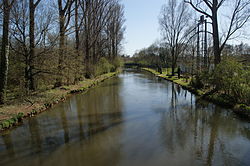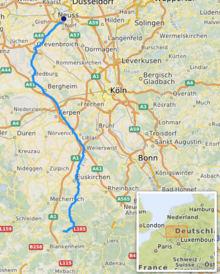
Back نهر ارفت (نهر) ARZ Erft CEB Эрфт CV Erft Danish Erft German Ερφτ Greek Río Erft Spanish ارفت Persian Erft French Erftas Lithuanian
| Erft | |
|---|---|
 Lower reaches of the Erft near Bergheim | |
 Cours of the river Erft [1] | |
| Location | |
| Country | Germany |
| State | North Rhine-Westphalia |
| Reference no. | DE: 274 |
| Physical characteristics | |
| Source | |
| • location | Southeast of Engelgau as the Kuhbach Signed source of the Erft near Holzmülheim |
| • coordinates | 50°29′14″N 6°35′14″E / 50.48722°N 6.58722°E |
| • elevation | 527 m above sea level (NHN) |
| Mouth | |
• location | Rhine near Neuss-Grimlinghausen |
• coordinates | 51°11′04″N 6°43′54″E / 51.18444°N 6.73167°E |
• elevation | 31 m above sea level (NHN) |
| Length | 106.6 km (66.2 mi) (incl. Kuhbach)[1] |
| Basin size | 1,837.915 km2 (709.623 sq mi) [1] |
| Discharge | |
| • location | at Neubrück gauge[2] |
| • average | 16.4 m3/s (580 cu ft/s) |
| • minimum | Record low: 5.15 m3/s (182 cu ft/s) (in 16.07.2007) Average low: 10.4 m3/s (370 cu ft/s) |
| • maximum | Average high: 31.3 m3/s (1,110 cu ft/s) Record high: 46.6 m3/s (1,650 cu ft/s) (in 04.06.1984) |
| Basin features | |
| Progression | Rhine→ North Sea |
| Landmarks |
|
| Tributaries | |
| • left | Veybach, Rotbach, Neffelbach |
| • right | Swist, Gillbach, Norfbach |
The Erft (pronounced [ʔɛɐ̯ft]) is a river in North Rhine-Westphalia, Germany. It flows through the foothills of the Eifel, and joins the Lower Rhine (left tributary). Its origin is near Nettersheim, and its mouth in Neuss-Grimlinghausen south of the Josef Cardinal Frings Bridge. The river is 106.6 kilometres (66.2 mi) long, which is significantly shorter than it was originally. Due to the open-pit mining of lignite in the Hambacher Loch, the flow of the river had to be changed.
The Erft gave its name to the town of Erftstadt, through which it flows, as well as to the Rhein-Erft district. It also flows through the towns of Bad Münstereifel, Euskirchen, Bergheim, Bedburg and Grevenbroich.